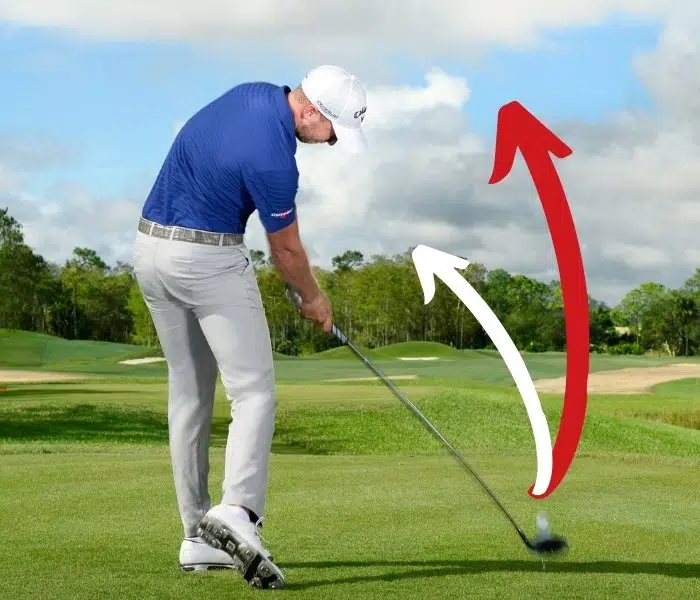Mastering the Swing: How to Stop Shanking a Golf Ball and Improve Your Game
Key Takeaway:
- Understanding the causes of shanking in golf is crucial for preventing it. Stance, grip, swing, and mental factors can all contribute to shanking.
- Techniques to prevent shanking include adjusting stance and posture, correcting grip and tension, improving swing path and weight distribution, and addressing mental blocks and confidence.
- Drills and exercises can be effective in eliminating shanks. These include checking impact spot on the club face, using a second barrier ball, monitoring hip positioning, getting distance right, and practicing other recommended drills and exercises.
Introduction to Shanking Golf Shots
Shanking golf shots can be frustrating, but understanding the causes behind it is key to improvement. In this introduction, we will explore the various factors that contribute to shanking, shedding light on the physics, mechanics, and mental aspects involved. By gaining insight into the causes of shanking, you will be better equipped to analyze and rectify your swing, ultimately leading to more accurate and enjoyable rounds on the golf course.
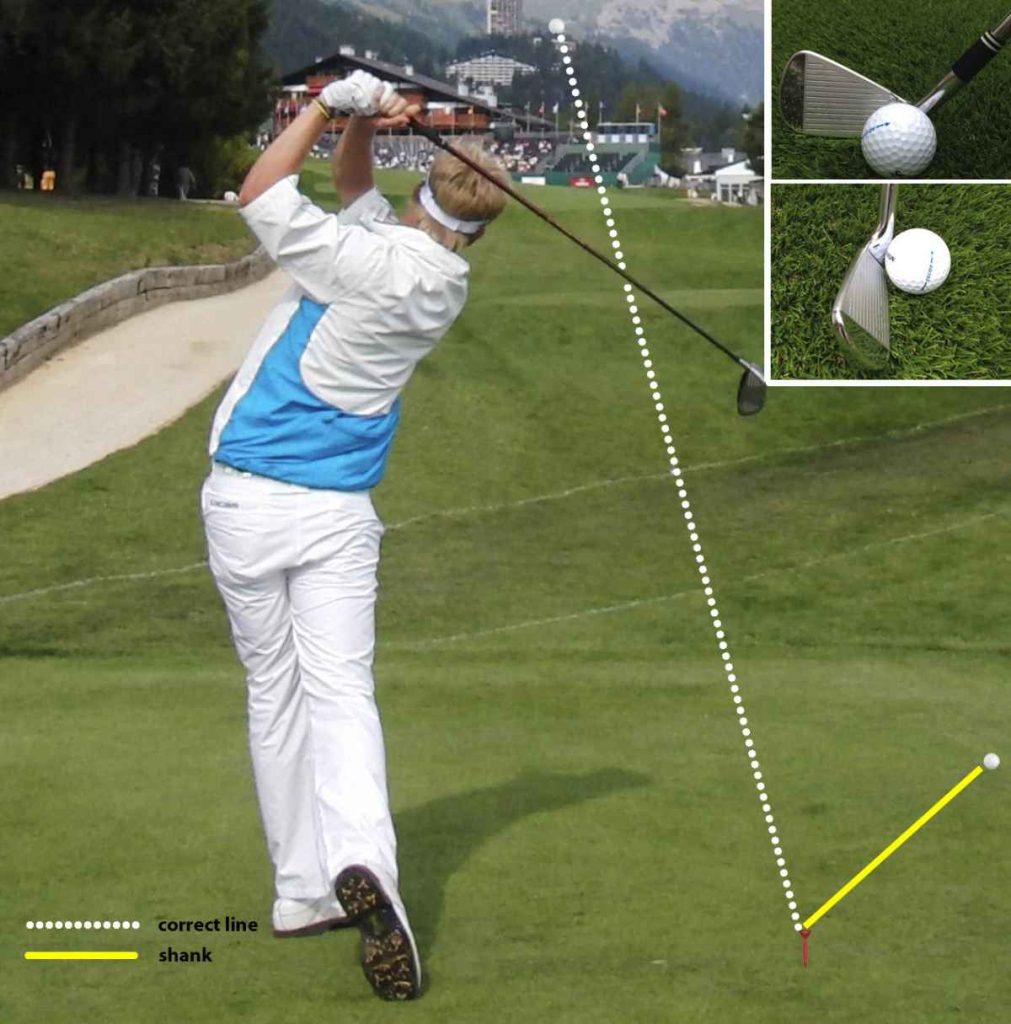
Understanding the Causes of Shanking
Shanking is a common golfing issue. It happens when the club’s hosel hits the ball, causing an errant shot that veers off to the right for right-handed golfers. To understand why this happens, it’s important to look at the possible causes.
These include:
- Stance-related causes: Alignment, weight on toes, etc.
- Grip-related causes: Holding the club too tightly, wrong positions, etc.
- Swing-related causes: Overly steep downswing plane, over-the-top position, etc.
- Mental factors: Anxiety, fear, negative self-talk, etc.
To fix shanking, golfers must address each cause individually, rather than just one. They should also be aware of how each element influences their swing mechanics. And they should use techniques like adjusting stance, correcting grip/tension, improving swing path/weight distribution, and building confidence. This will help them strike better and ultimately improve their performance on the course.
Stance-related Causes
Golfers can be plagued by the pesky shank, which can be caused by improper factors related to stance. Such as:
- Foot alignment too open or closed to the target line.
- Ball placement too far forward or back in the stance.
- Knees too straight or overly bent.
- Excessive slouching or leaning too far forward.
Improving these aspects is key to improving your game. It’ll bring more confidence and better ball striking, helping you have an enjoyable and successful golf game. But beware, the shanks will always find a way to sneak in, whether you have a firm or loose grip!
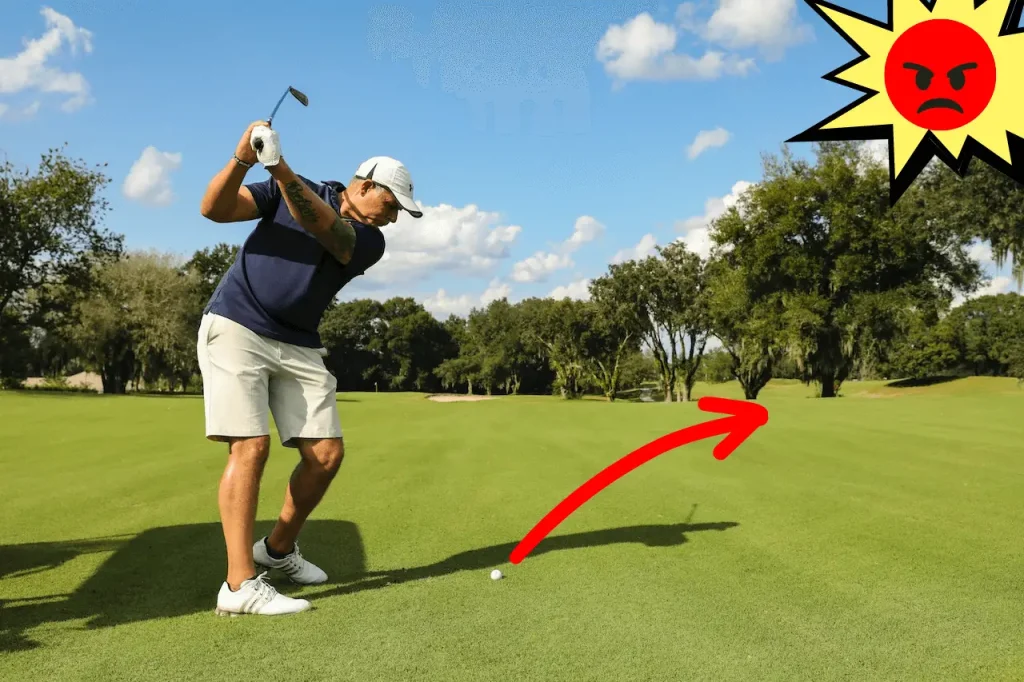
Grip-related Causes
Golfers having trouble with shanks should pay special attention to grip-related causes. This includes finding the right grip pressure, hand placement, and finger control.
To get the correct grip pressure, golfers should aim for a balance between too tight and too loose. This allows for natural wrist movement while still maintaining control over the club.
Hand positioning should be equal on both hands, neither dominating the other. This way, the swing will be more balanced and off-center strikes are prevented.
Finger control requires practice and exercises that promote proper finger placement and strength. Gripping exercises or training aids can help develop better finger control. This leads to a stable and controlled grip, allowing for more consistent strikes.
By focusing on these grip-related causes, golfers can reduce shanks and improve their overall golf game.
Swing-related Causes
Swinging a golf club incorrectly can lead to shanked shots – where the ball is hit off the hosel and goes off-target. Causes include: poor swing path, lack of weight transfer, incorrect grip pressure, overswinging, and tension in the arms and body.
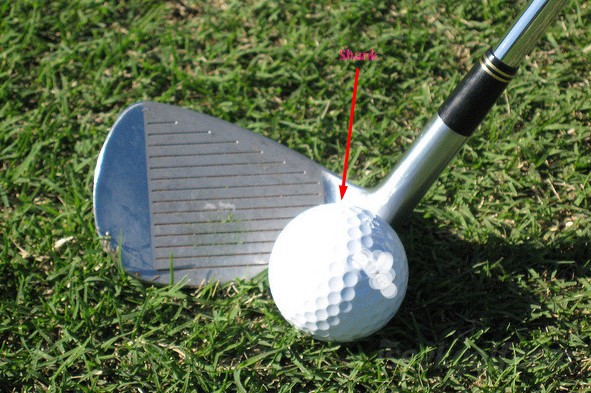
These issues can be solved by proper instruction and practice. Golfers must focus on improving their swing path, weight transfer, grip pressure, and relaxation during their swings.
A golfer who was struggling with shanked shots due to an incorrect swing path, sought help from a professional instructor. With targeted drills against his club path, he was able to remove shanked shots from his game. This story reveals how addressing swing-related causes can improve one’s ability to play better.
Hitting a shanked golf ball is like accidentally hitting a bee’s nest with a stick – never a good outcome.
Mental Factors Contributing to Shanking
Mental factors can have a huge impact on shanking golf shots. How a golfer thinks and feels during their swing can drastically affect the accuracy and reliability of their shots. These mental factors are often forgotten but can be very influential in causing shanks.
Anxiety or lack of confidence can lead to tensed muscles and an unsteady swing. Negative thoughts or distractions can also disturb focus and timing, resulting in off-centre hits.
One obstacle golfers may face mentally is the fear of hitting a shank. This fear can create a mental block or hesitation during the swing, leading to tight muscles and an improper club path. This then turns into a cycle where the fear of shanking increases the chance of it happening.
To overcome these mental factors contributing to shanking, golfers need to rethink their mindset and discover techniques to stay calm, confident and focused on each shot. Visualization, positive self-talk and deep breathing exercises can assist golfers in staying composed under pressure.
By detecting any negative thought patterns or beliefs about shanking and replacing them with positive affirmations or productive thoughts, golfers can rewire their minds for success on the course. Mental training programs or working with a sports psychologist may also be beneficial for golfers trying to enhance their mental game.
Realizing the mental factors contributing to shanking is essential for golfers wishing to improve their game. By tackling these factors straight on and employing effective techniques to combat them, golfers can increase their performance and gain more consistent and precise shots on the course.
If you’re hoping to rescue your swing from shanking, you need more than a Band-Aid – it’s time for a full-on golf CPR!
Techniques to Prevent Shanking
Looking to improve your golf game and eliminate those pesky shanks? Look no further than the techniques to prevent shanking. In this section, we’ll explore various strategies to fine-tune your game, from adjusting your stance and posture to correcting your grip and tension. We’ll also delve into improving your swing path and weight distribution, as well as addressing any mental blocks or lack of confidence that may be hindering your performance on the green. Get ready to level up your golfing skills!
Adjusting Stance and Posture
Golfers should adjust stance and posture to avoid shanking. Make changes to body position and balance to improve the swing and accuracy. Feet, body alignment, and weight distribution must be considered.
Feet: Shoulder-width apart, knees slightly bent. This creates a steady base for better control and balance.
Body: Parallel to the target line, both shoulders facing the intended target. Ensures a consistent swing path and reduces side spin.
Posture: Spine straight, tilt slightly from the hips. No hunching or arching, this restricts mobility and affects swing mechanics.
Weight: Evenly distributed, with more on balls of the feet. Allows proper weight transfer and adds power.
Tension: Avoid excessive tension, stay relaxed. Relaxed grip pressure ensures fluidity and prevents tension from impacting ball striking.
Practice regularly to refine stance and posture. Different widths of the stance may have benefits, and maintain a consistent distance from the ball relative to each club.
Make adjustments today and witness the improvements in the golf game. Get a grip and loosen up any tension for a smoother swing and fewer shanks!
Correcting Grip and Tension
When boosting your golfing game and lessening shanking, grip and tension are key. To adjust, here’s what to do:
- Check your grip: Look at how your hands are on the club handle. Make sure they’re in the right spot and that you hold the club firmly and relaxed.
- Change hand placement: If your grip is too tight or loose, try shifting your hands to different spots. Find what feels most comfy.
- Position fingers correctly: Notice how your fingers cling to the club. Aim for a secure hold with both hands, using both fingers and palms.
- Get the right tension: Strike a balance between gripping too hard and not enough. Look for moderate tension to keep control and power while staying flexible.
- Keep it consistent: Once you’ve found the right grip and tension, practice it. Create muscle memory by repeating the correct grip and tension each time you swing.
You might have other unique details that can be addressed when correcting grip and tension. Talk to a coach or instructor for tailored advice and further improve your game.
Swing like a conductor, finding the ideal harmony between your swing and weight distribution.
Improving Swing Path and Weight Distribution
To improve your swing path and weight distribution, use this 3-step guide:
- Have a Consistent Swing Path: See if your swing path has any mistakes or changes. Work with a golf instructor or watch videos to know how to swing properly. Practice drills like the “gate drill” where you place two sticks on the target line.
- Balance Your Weight: At the start, keep your weight even on both feet. Lean your weight towards your back foot in the backswing. Move weight to your front foot for power and control in the downswing.
- Use Your Core: Make your core strong and flexible with exercises for your abs, lower back, and hips. This will help you stay balanced while you swing.
These steps will help you hit the ball better. Also, remember to stay focused, relaxed, and think of a good shot before you swing. Doing this consistently will help you get better at golf and get rid of shanks. Use your mind to make shanks disappear like magic!
Addressing Mental Blocks and Confidence
Addressing mental blocks is key for any golfer’s success. To do this, visualization and positive self-talk can help build confidence and reduce negative thoughts during a round. Working with a sports psychologist or mental coach can also provide guidance.
Developing confidence is also important. This lets golfers trust their skills and make better swings. Confidence can be built through consistent practice, reflecting on past successes, and focusing on strengths.
Addressing mental blocks and confidence is an ongoing process that requires time and patience. It is essential to keep practicing mental skills and seek help if necessary.
Golfers who have addressed mental blocks have seen great improvement in their game. Their scores were lower and they enjoyed the sport more (Testimonials from Golfers).
Drills and Exercises to Eliminate Shanks
Discover effective drills and exercises that can help you eliminate shanks in your golf game. From checking the impact spot on the club face to monitoring hip positioning and getting the distance right, these techniques will transform your swing. Dive into the world of golf improvement and explore other recommended drills and exercises that will make those shanks a thing of the past. Get ready to take your golf game to the next level!
Checking Impact Spot on the Club Face
Checking the impact spot on the club face is an essential part of golf technique. A well-placed impact spot can help players achieve better shots in terms of distance and accuracy.
To check the club face impact spot, here are four steps:
- Set up, align body and clubface towards target.
- Take a swing, make contact with ball.
- Check ball mark location on club face.
- Impact should be in center or slightly towards sweet spot.
Checking the impact spot regularly can help identify any swing inconsistencies. Plus, factors like swing speed and angle of attack can also affect where and how the energy is transferred from the swing to the ball.
By understanding and refining the impact spot, you can develop a more consistent and efficient golf swing. This will, in turn, improve your performance on the course.
Using a Second Barrier Ball
- Introduce a second barrier ball to your golf game. It boosts your swing path and ensures solid contact with the primary golf ball. This forces you to hit more centered strikes, eliminating off-hosel shots. It also encourages proper weight distribution and balance. This can reduce mental blocks and anxiety associated with shanking, giving you more confidence.
- Incorporate the second barrier ball into your practice routine. Enjoy more control and accuracy in your golf game. Make sure your hips are in check to avoid shanking and hit the fairway with confidence.
Monitoring Hip Positioning
For proper alignment and positioning when golfing, monitoring hip positioning is key. This affects balance, and can help generate power and accuracy. By focusing on hip positioning, golfers can improve their performance and reduce the risk of shanking.
To do this, try:
- Making sure hips rotate during the swing.
- Keeping hips centered for a stable base.
- Preventing lateral movement of the hips.
- Smoothly transferring weight from backswing to downswing.
- Engaging core muscles for hip stability and control.
- Timing hip rotation and arm swing.
This will help golfers maintain optimal hip positioning, making their shots more consistent and accurate. Plus, it’ll boost power in the swing, and prevent shanking. To make the most of these techniques, golfers should practice them regularly.
With proper hip alignment, weight transfer is more controlled and efficient. Core muscle engagement supports stability, and helps coordinate hips and arms. Through monitoring hip positioning, golfers can take control of their shots and hit more accurate shots on the course.
Getting Distance Right
Mastering the skill of getting the perfect distance with golf shots is essential for improving your game. You need the right balance between power and control. Here are key techniques to get it right:
- Adjust your stance and posture. Properly align your body and position yourself correctly near the ball. This will optimize your body’s movement.
- Get your grip and tension right. Correctly placing both hands on the club is important. Also, make sure your grip isn’t too tight or too loose.
- Improve your swing path and weight distribution. Focus on a straight path and smoothly transfer weight from backswing to downswing.
- Overcome mental blocks. Fear and doubt can hinder performance. Increase your confidence for smoother swings and greater distance.
By using these techniques, you will get distance right consistently. This will lead to more successful shots and improved performance on the course.
Other Recommended Drills and Exercises
To improve your golf game and stop shanking, there are specific drills and exercises that can help. For example, check the club face impact spot after each shot. This will help you hit the ball in the center of the club face.
Another exercise is to use a second barrier ball. Place the smaller ball outside your target line. You will need to swing accurately to avoid it.
Monitoring your hip positioning is also important. Good hip movement and rotation lead to better balance and alignment. This reduces the chances of shanking.
Other recommended strategies that have helped golfers include relaxing their grip, visualizing successful shots, and doing these exercises in practice.
One golfer shared how they overcame shanking. They checked the impact spot on the club face and used a barrier ball. They also monitored their hip positioning and improved their game.
Implementing these drills and exercises can help you eliminate shanking and enhance your golf game. Do it consistently and you will hit better shots on the course. Don’t be a “shankosaur”! Read success stories from golfers who have overcome shanking.
Testimonials and Success Stories from Golfers
Golfers around the world have shared their success stories and testimonials of beating shanking. These stories provide motivation and useful strategies for those facing the same issue.
- Golfers have shared how they overcame shanking through correct alignment and posture.
- Drills and exercises have been recommended to enhance accuracy and eliminate shanks.
- Golfers have adjusted their grip and clubface angle to regain control and consistency.
- Mental focus and visualization techniques are essential to avoid shanking.
- Seeking professional guidance and personalized instruction can improve shanks.
These testimonials demonstrate the importance of perseverance and dedication. Golfers who have conquered shanking show that the right techniques and help can make a difference. Their stories demonstrate that commitment to improvement and passion for golf can pay off.
Testimonials and success stories from golfers offer insights and guidance for overcoming shanking. By learning these strategies, golfers can improve their performance and enjoy the game more. Don’t miss out on this opportunity – start implementing these techniques and see the results!
Conclusion: Overcoming Shanking and Improving Your Golf Game
Shanking is a common issue for golfers that can really hurt their performance. But there are ways to beat this! By understanding why it happens and using certain techniques, players can reduce shanking and improve their golfing skills.
Balance and alignment are very important. Feet should be shoulder-width apart and weight should be evenly distributed. Additionally, a good grip and relaxed posture can help with consistency and decrease shanking.
Drills and exercises can also help. These include using alignment sticks, a foam ball to work on contact, and a towel as a training aid. Practicing these regularly makes it easier to hit the ball accurately.
It’s also important to prepare mentally. Have a pre-shot routine and visualise successful shots. This builds confidence and reduces anxiety, which can cause shanking. Focus on positive imagery and stay relaxed.
In summary, shanking can be a pain. But with the right techniques and dedication, golfers can overcome it and have a better time on the course.
Some Facts About How To Stop Shanking a Golf Ball:
- ✅ The shank is a dreaded and embarrassing golf shot where the ball goes 90 degrees away from the intended target line. (Source: Team Research)
- ✅ Standing too close to the ball is a common cause of shank shots. (Source: Free-Online-Golf-Tips.com)
- ✅ Holding the club too tightly and attempting to cut across the ball or hit it inside out can also lead to shanking. (Source: NickFoyGolf.com)
- ✅ To prevent shank shots, golfers should check their stance, adjust their weight balance, and get their swing path right. (Source: SportsRec.com)
- ✅ Practicing drills that focus on setup position, weight distribution, and swing path can help eliminate shanks from a golfer’s game. (Source: GolfWRX.com)
FAQs about How To Stop Shanking A Golf Ball
FAQ 1: What are the major causes of shanked golf shots?
The major causes of shanked golf shots include standing too close to the ball, incorrect weight distribution, an over the top swing error, and improper posture and setup.
FAQ 2: How can I prevent shanked golf shots?
To prevent shanked golf shots, you can check your stance, adjust your weight balance, work on your swing path, fix any swing errors, and ensure proper posture and setup.
FAQ 3: Are there any drills that can help reduce shanking in golf?
Yes, there are drills that can help reduce or eliminate shanking from your golf swing. Some of these drills include recording impact spots on the club face, using a second barrier ball, and monitoring hip positioning.
FAQ 4: Why is it counterintuitive to move the ball closer to the heel of the club to avoid shanks?
Moving the ball closer to the heel of the club is counterintuitive because it encourages adjustments in your swing that help you hit the sweet spot on the ball, reducing the chances of shanking.
FAQ 5: How can I stop shanking the ball when swinging a driver for 300-yard drives?
To stop shanking the ball when swinging a driver, you can ensure proper setup and posture, maintain a light grip and tension-free arms, and focus on a consistent release during your swing.
FAQ 6: What causes shanking in golf and how can I address it?
Shanking in golf is often caused by striking the ball too far out of the heel or hosel of the club. To address it, you can adjust your ball position, weight distribution, and swing path, and seek guidance from golf professionals if needed.
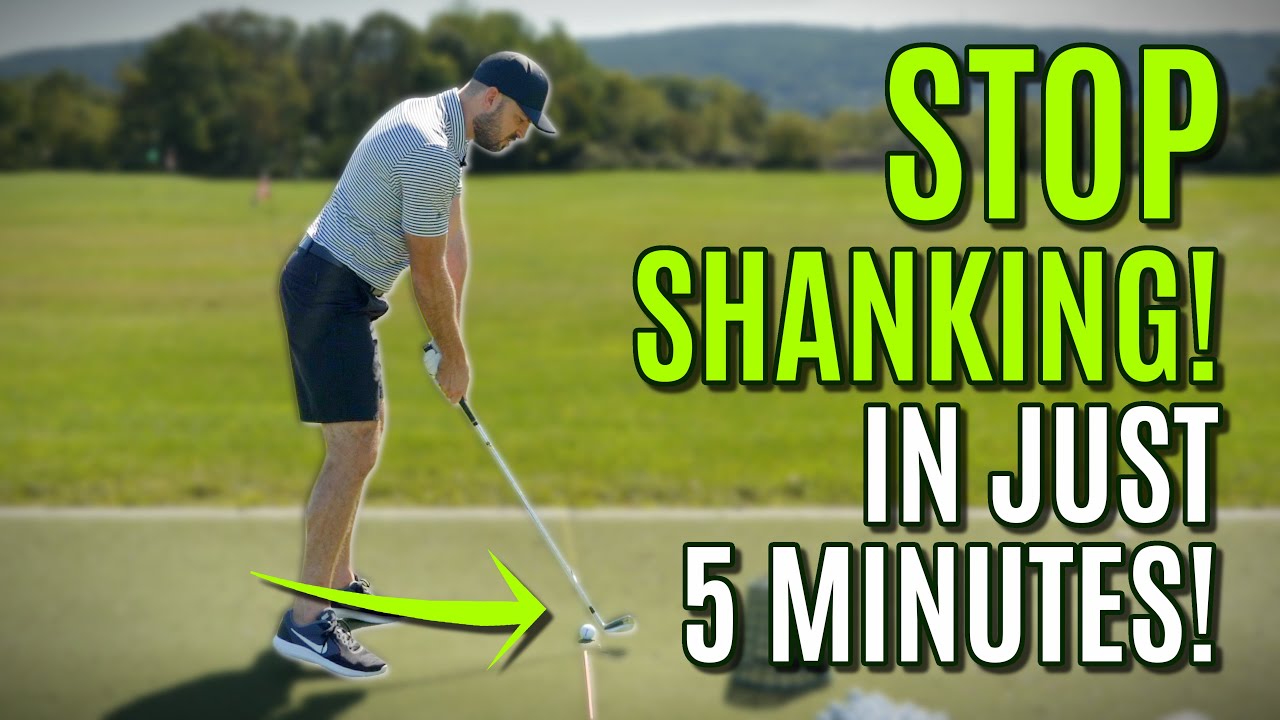


![Master Your Golf Swing with the Perfect Irons: Tips and Tricks [2024]](https://www.fairwayfindings.com/wp-content/uploads/2024/03/Master-Your-Golf-Swing-with-the-Perfect-Irons-768x768.webp)

